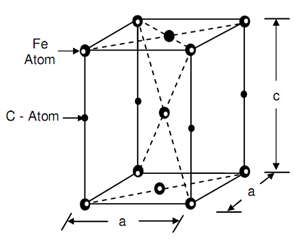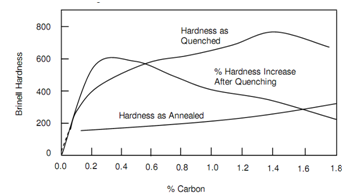Hardening
If a part of steel is heated 30-50oC above A3 temperature whole austenitizing is allowed by soaking at that temperature and after that cooled suddenly or quenched, the breakdown of austenite is suppressed. The new phase such forms is martensite whether all the dissolved carbon is held in form of body centered tetragonal structure represented in figure of The Unit Cell of Distorted Body-centered Tetragonal Lattice of Martensite. Martensite is merely Meta stable phase and might be tempering. This is extremely brittle and hard and has a characteristic acicular appearance while examined beneath microscope beneath high magnification. In the steels upto eutectoid composition, the martensite appearance via this drastic quenching operation comprises all the carbon such was contained in austenite. However, in higher eutectoid steels, several carbons are converted into carbide particles also.

Figure: The Unit Cell of Distorted Body-centered Tetragonal Lattice of Martensite
The martensite hardness is dependent on the percentage of carbon there in structure. Following figure demonstrates how this hardness varies along with carbon content. This can be seen as; hardness of plain carbon steels increases fast till the eutectoid composition is reached. After such composition the hardness raises very usually. It means that the hardest martensite is formed at eutectoid composition whilst hardness remains at such level in hypereutectoid steels. The slight raise in hardness of hypereutectoid steel is because of formation of carbide particles that are brittle and hard.

Figure: Variation of Hardness of Martensite along with Carbon Content of Steel